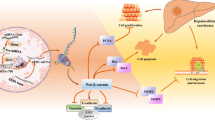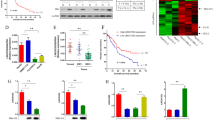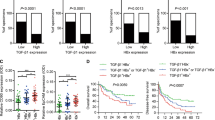Abstract
Hepatitis B virus (HBV)-induced liver necrosis takes great part in liver cirrhosis progression. However, less is known about whether hepatitis B virus X protein (HBx) has effect on liver fibrosis. Here, we report that HBV leads to liver fibrosis and hepatocarcinogenesis through miR-30e targeting P4HA2. HBV transgenic mouse was treated by CCl4 to generate a model of liver fibrosis. A crucial enzyme catalyzing collagen formation, prolyl 4-hydroxylase subunit α2 (P4HA2) was evaluated by immunohistochemistry, western blotting or quantitative reverse transcription–PCR analysis. The function of HBV-modulated P4HA2 in hepatoma cell growth in vitro and in vivo was analyzed by EdU, MTT, colony-forming assay and animal transplantation assay. HBV transgenic mice exhibited more collagen deposition in liver after intraperitoneal injection of CCl4. P4HA2 was dramatically augmented in liver samples of HBV transgenic mice, clinical liver cirrhosis and liver cancer patients. Mechanistically, HBx was capable of inducing P4HA2 through suppressing miR-30e, in which miR-30e could target P4HA2 mRNA 3' untranslated region in liver cancer cells. HBx inhibited the miR-30e expression through increasing methylation of CpG islands in its promoter mediated by EZH2-formed complexes. Functionally, HBx-elevated P4HA2 enhanced the collagen deposition in the liver in vivo and in vitro, leading to liver fibrosis and liver cancer progression. In conclusion, HBx promotes the development of liver fibrosis and hepatocellular carcinoma through miR-30e targeting P4HA2 mRNA. We provide novel perspective on how HBx induces liver fibrosis.
This is a preview of subscription content, access via your institution
Access options
Subscribe to this journal
Receive 50 print issues and online access
$259.00 per year
only $5.18 per issue
Buy this article
- Purchase on Springer Link
- Instant access to full article PDF
Prices may be subject to local taxes which are calculated during checkout







Similar content being viewed by others
References
Sinn DH, Lee J, Goo J, Kim K, Gwak GY, Paik YH et al. Hepatocellular carcinoma risk in chronic hepatitis B virus-infected compensated cirrhosis patients with low viral load. Hepatology 2015; 62: 694–701.
Xu C, Zhou W, Wang Y, Qiao L . Hepatitis B virus-induced hepatocellular carcinoma. Cancer Lett 2014; 345: 216–222.
Zhang XD, Wang Y, Ye LH . Hepatitis B virus X protein accelerates the development of hepatoma. Cancer biology & medicine 2014; 11: 182–190.
Pungpapong S, Kim WR, Poterucha JJ . Natural history of hepatitis B virus infection: an update for clinicians. Mayo Clin Proc 2007; 82: 967–975.
De Martel C, Maucort-Boulch D, Plummer M, Franceschi S . World-wide relative contribution of hepatitis B and C viruses in hepatocellular carcinoma. Hepatology 2015; 62: 1190–1200.
Kayashima H, Maeda T, Harada N, Masuda T, Guntani A, Ito S et al. Risk factors for incisional hernia after hepatic resection for hepatocellular carcinoma in patients with liver cirrhosis. Surgery 2015; 158: 1669–1675.
Wells RG . Cellular sources of extracellular matrix in hepatic fibrosis. Clin Liver Dis 2008; 12: 759–768.
Zhang R, Cao Y, Bai L, Zhu C, Li R, He H et al. The collagen triple helix repeat containing 1 facilitates hepatitis B virus-associated hepatocellular carcinoma progression by regulating multiple cellular factors and signal cascades. Mol Carcinog 2015; 54: 1554–1566.
Yang SL, Liu LP, Sun YF, Yang XR, Fan J, Ren JW et al. Distinguished prognosis after hepatectomy of HBV-related hepatocellular carcinoma with or without cirrhosis: a long-term follow-up analysis. J Gastroenterol 2016; 51: 722–732.
Joo S, Kim JY, Lee E, Hong N, Sun W, Nam Y . Effects of ECM protein micropatterns on the migration and differentiation of adult neural stem cells. Sci Rep 2015; 5: 1–12.
McMillen P, Holley SA . Integration of cell-cell and cell-ECM adhesion in vertebrate morphogenesis. Curr Opin Cell Biol 2015; 36: 48–53.
Sim JY, Moeller J, Hart KC, Ramallo D, Vogel V, Dunn AR et al. Spatial distribution of cell-cell and cell-ECM adhesions regulates force balance while maintaining E-cadherin molecular tension in cell pairs. Mol Biol Cell 2015; 26: 2456–2465.
Tameda M, Sugimoto K, Shiraki K, Yamamoto N, Okamoto R, Usui M et al. Collagen triple helix repeat containing 1 is overexpressed in hepatocellular carcinoma and promotes cell proliferation and motility. Int J Oncol 2014; 45: 541–548.
Gilkes DM, Bajpai S, Chaturvedi P, Wirtz D, Semenza GL . Hypoxia-inducible factor 1 (HIF-1) promotes extracellular matrix remodeling under hypoxic conditions by inducing P4HA1, P4HA2, and PLOD2 expression in fibroblasts. J Biol Chem 2013; 288: 10819–10829.
Li J, Ghazwani M, Zhang Y, Lu J, Li J, Fan J et al. miR-122 regulates collagen production via targeting hepatic stellate cells and suppressing P4HA1 expression. J Hepatol 2013; 58: 522–528.
Chang KP, Yu JS, Chien KY, Lee CW, Liang Y, Liao CT et al. Identification of PRDX4 and P4HA2 as metastasis-associated proteins in oral cavity squamous cell carcinoma by comparative tissue proteomics of microdissected specimens using iTRAQ technology. J Proteome Res 2011; 10: 4935–4947.
Jarzab B, Wiench M, Fujarewicz K, Simek K, Jarzab M, Oczko-Wojciechowska M et al. Gene expression profile of papillary thyroid cancer: sources of variability and diagnostic implications. Cancer Res 2005; 65: 1587–1597.
Xiong GF, Deng L, Zhu JQ, Rychahou PG, Xu R . Prolyl-4-hydroxylase a subunit 2 promotes breast cancer progression and metastasis by regulating collagen deposition. BMC Cancer 2014; 14: 1–12.
Sze KMF, Chu GKY, Lee JMF, Ng IOL . C-terminal truncated hepatitis B virus x protein is associated with metastasis and enhances invasiveness by c-jun/matrix metalloproteinase protein 10 activation in hepatocellular carcinoma. Hepatology 2013; 57: 131–139.
You X, Liu F, Zhang T, Lv N, Liu Q, Shan C et al. Hepatitis B virus X protein upregulates Lin28A/Lin28B through Sp-1/c-Myc to enhance the proliferation of hepatoma cells. Oncogene 2014; 33: 449–460.
Zhang Y, Zhao YR, Liu HL, Yi RT, Niu YH, Cui ML et al. HBV whole-X and HBx play distinct roles in the HBV-related HCC progression. Hepatology 2012; 56: 617a–617a.
You X, Liu F, Zhang T, Li Y, Ye L, Zhang X . Hepatitis B virus X protein upregulates oncogene Rab18 to result in the dysregulation of lipogenesis and proliferation of hepatoma cells. Carcinogenesis 2013; 34: 1644–1652.
Zhang S, Shan C, Cui W, You X, Du Y, Kong G et al. Hepatitis B virus X protein protects hepatoma and hepatic cells from complement-dependent cytotoxicity by up-regulation of CD46. FEBS Lett 2013; 587: 645–651.
Park ES, Park YK, Shin CY, Park SH, Ahn SH, Kim DH et al. Hepatitis B virus inhibits liver regeneration via epigenetic regulation of urokinase-type plasminogen activator. Hepatology 2013; 58: 762–776.
Park IY, Sohn BH, Yu E, Suh DJ, Chung YH, Lee JH et al. Aberrant epigenetic modifications in hepatocarcinogenesis induced by hepatitis B virus X protein. Gastroenterology 2007; 132: 1476–1494.
Song K, Han C, Wu T . Epigenetic regulation of miR-122 expression by PPAR gamma/RXR alpha complex and HBx in hepatocellular carcinoma. Hepatology 2013; 58: 1681–1692.
Shan C, Zhang S, Cui W, You X, Kong G, Du Y et al. Hepatitis B virus X protein activates CD59 involving DNA binding and let-7i in protection of hepatoma and hepatic cells from complement attack. Carcinogenesis 2011; 32: 1190–1197.
Su X, Xing J, Wang Z, Chen L, Cui M, Jiang B . microRNAs and ceRNAs: RNA networks in pathogenesis of cancer. Chin J Cancer Res 2013; 25: 235–239.
Chakravarthi BV, Pathi SS, Goswami MT, Cieslik M, Zheng H, Nallasivam S et al. The miR-124-prolyl hydroxylase P4HA1-MMP1 axis plays a critical role in prostate cancer progression. Oncotarget 2014; 5: 6654–6669.
Chen RJ, Kelly G, Sengupta A, Heydendael W, Nicholas B, Beltrami S et al. MicroRNAs as biomarkers of resilience or vulnerability to stress. Neuroscience 2015; 305: 36–48.
Haflidadottir BS, Ceder Y . Exosomal microRNAs as potential biomarkers in castration-resistant prostate cancer. Eur Urol 2015; 67: 42–43.
Kriegel AJ, Baker MA, Liu Y, Liu P, Cowley AW Jr, Liang M . Endogenous microRNAs in human microvascular endothelial cells regulate mRNAs encoded by hypertension-related genes. Hypertension 2015; 66: 793–799.
Wang Y, Chen J, Lin Z, Cao J, Huang H, Jiang Y et al. Role of deregulated microRNAs in non-small cell lung cancer progression using fresh-frozen and formalin-fixed, paraffin-embedded samples. Oncol Lett 2016; 11: 801–808.
Bhattacharya S, Steele R, Shrivastava S, Chakraborty S, Di Bisceglie AM, Ray RB . Serum miR-30e and miR-223 as novel noninvasive biomarkers for hepatocellular carcinoma. Am J Pathol 2016; 186: 242–247.
Feng G, Shi H, Li J, Yang Z, Fang R, Ye L et al. MiR-30e suppresses proliferation of hepatoma cells via targeting prolyl 4-hydroxylase subunit alpha-1 (P4HA1) mRNA. Biochem Biophys Res Commun 2016; 472: 516–522.
Zhang T, Zhang J, Cui M, Liu F, You X, Du Y et al. Hepatitis B virus X protein inhibits tumor suppressor miR-205 through inducing hypermethylation of miR-205 promoter to enhance carcinogenesis. Neoplasia 2013; 15: 1282–1291.
Pihlajaniemi T, Myllyla R, Kivirikko KI . Prolyl 4-hydroxylase and its role in collagen synthesis. J Hepatol 1991; 13: 2–7.
Viré E, Brenner C, Deplus R, Blanchon L, Fraga M, Didelot C et al. The polycomb group protein EZH2 directly controls DNA methylation. Nature 2006; 439: 871–874.
Shi XY, Zhang YY, Zhou XW, Lu JS, Guo ZK, Huang PT . Hepatitis B virus X protein regulates the mEZH2 promoter via the E2F1-binding site in AML12 cells. Chin J Cancer 2011; 30: 273–279.
Lin C, Yang D, Jiang Y, He F-C . The role of HBx in regulating the genesis of hepatocellular carcinoma. Chinese Journal of Biochemistry & Molecular Biology 2013; 29: 704–710.
Yi T, Xiao X, Xing G, Feng P, Yun X, Jiang Y et al. HBx promotes cell proliferation by disturbing the cross-talk between miR-181a and PTEN. Sci Rep 2017; 7: 1–11.
Zhu MY, Guo JL, Li W, Lu Y, Fu SG, Xie XJ et al. Hepatitis B virus X protein induces expression of alpha-fetoprotein and activates PI3K/mTOR signaling pathway in liver cells. Oncotarget 2015; 6: 12196–12208.
Karsdal MA, Genovese F, Madsen EA, Manon-Jensen T, Schuppan D . Collagen and tissue turnover as a function of age: implications for fibrosis. J Hepatol 2016; 64: 103–109.
Jin Z, Sun R, Wei H, Gao X, Chen Y, Tian Z . Accelerated liver fibrosis in hepatitis B virus transgenic mice: Involvement of natural killer T cells. Hepatology 2011; 53: 219–229.
Wong CM, Wong CC, Lee JM, Fan DN, Au SL, Ng IO . Sequential alterations of microRNA expression in hepatocellular carcinoma development and venous metastasis. Hepatology 2012; 55: 1453–1461.
Cushing L, Kuang P, Lu J . The role of miR-29 in pulmonary fibrosis. Biochem Cell Biol 2015; 93: 109–118.
Zanotti S, Gibertini S, Curcio M, Savadori P, Pasanisi B, Morandi L et al. Opposing roles of miR-21 and miR-29 in the progression of fibrosis in Duchenne muscular dystrophy. Biochim Biophys Acta 2015; 1852: 1451–1464.
Li J, Ghazwani M, Zhang YF, Lu JQ, Li JL, Fan J et al. miR-122 regulates collagen production via targeting hepatic stellate cells and suppressing P4HA1 expression. J Hepatol 2013; 58: 522–528.
Zhang W, Lu Z, Kong G, Gao Y, Wang T, Wang Q et al. Hepatitis B virus X protein accelerates hepatocarcinogenesis with partner survivin through modulating miR-520b and HBXIP. Mol Cancer 2014; 13: 1–14.
Acknowledgements
This work was supported by the grants of National Natural Science Foundation of China (No. 81372186, 31470756, 31670769, 31670771) and National Basic Research Program of China (973 Program, No. 2015CB553905, 2015CB553703).
Author information
Authors and Affiliations
Corresponding authors
Ethics declarations
Competing interests
The authors declare no conflict of interest.
Additional information
Supplementary Information accompanies this paper on the Oncogene website
Supplementary information
Rights and permissions
About this article
Cite this article
Feng, G., Li, J., Yang, Z. et al. Hepatitis B virus X protein promotes the development of liver fibrosis and hepatoma through downregulation of miR-30e targeting P4HA2 mRNA. Oncogene 36, 6895–6905 (2017). https://doi.org/10.1038/onc.2017.291
Received:
Revised:
Accepted:
Published:
Issue Date:
DOI: https://doi.org/10.1038/onc.2017.291
This article is cited by
-
EZH2-mediated epigenetic silencing of tumor-suppressive let-7c/miR-99a cluster by hepatitis B virus X antigen enhances hepatocellular carcinoma progression and metastasis
Cancer Cell International (2023)
-
P4HA3 promotes clear cell renal cell carcinoma progression via the PI3K/AKT/GSK3β pathway
Medical Oncology (2023)
-
The long and short non-coding RNAs modulating EZH2 signaling in cancer
Journal of Hematology & Oncology (2022)
-
DNA methyltransferase 1 knockdown reverses PTEN and VDR by mediating demethylation of promoter and protects against renal injuries in hepatitis B virus-associated glomerulonephritis
Cell & Bioscience (2022)
-
LncRNA 1700020I14Rik promotes AKR1B10 expression and activates Erk pathway to induce hepatocyte damage in alcoholic hepatitis
Cell Death Discovery (2022)



